Trošku dlhší listing, lebo toto nevygúglite :-)
O RYBIANSKOM MALIAROVI
Bol raz jeden malý chlapec. Tento svet sa ho dočkal 13. septembra 1930. Dostal meno, aké bolo na tejto dedine úplne bežným menom: Jozef Žatko.
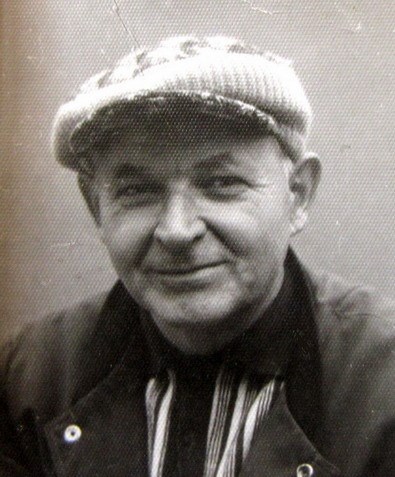
Ako rástol, pomáhal doma tak, ako všetky deti z tej dediny: s otcom oral, sial, zberal úrodu, kosil, pomáhal popri domácich zvieratách, mama ho naučila zvláštnemu citu ku druhým ľuďom, aj ku svetu. Večer v kuchyni počúval zážitky z dunajských lodných plavieb svojho otca Gabriela, ktorý tam slúžil ako zámočník. Mama Alžbeta bola vychýrená kuchárka a gazdiná, často varievala aj iným v dedine, ako gazdiná slúžila až v Pešti. Mal dve sestry, obe mladšie. A mal rád voľné chvíle, kedy si kreslieval ceruzkou na okraje starých novín. Tie mal úplne najradšej. V mládežníckych rokoch s bratrancami Teodorom a Jánom Žatkom radi organizovali vystúpenia „kúzelníka a hypnotizéra“ pre ostatné deti, kde sa na chvíľu budúci maliar zmenil na osvetľovača, výrobcu svetelných efektov a oponára aj asistenta v jednej osobe. Toto všetko zrejme vymodelovalo jeho profesijné, aj životné cesty: Sám sa neskôr stal akademickým maliarom, vyhľadávaným rozprávačom a zabávačom, šikovným domácim majstrovačom všetkého možného a popri krásnom manželstve s jeho Blankou (vyštudovanou sochárkou, rod. Longauerovou) stal sa postupne aj otcom šiestich detí. Ľudia, ktorí si ho pamätajú, vedia, že sa s ním dalo rozprávať o veľa témach. Rovnako ho zaujímalo štepenie ovocných stromov, hnojenie uhoriek, strihanie viniča, ako aj politika, filozofia, vážna hudba, divadlo, vedecké experimenty aj viera, murárčina, tesárčina, cestopisy, bol aj nadšeným amatérskym fotografom, miloval hory, horolezectvo, lyžovanie, jazdu motorkou, hru na fujare, ale aj tiché chvíle s udicou v zátokách ešte nezregulovanej Bebravy...
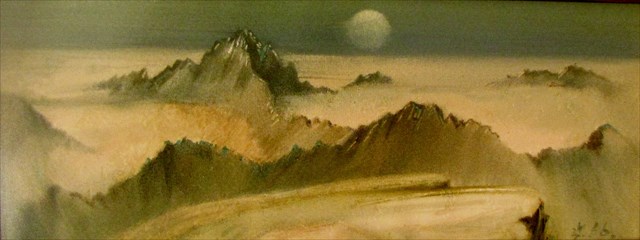
Na Vysokej škole výtvarných umení bol jeho profesorom maľby Ján Želibský, ale aj Vincent Hložník, po štúdiu pôsobil na VŠMU ako asistent. Okrem maľby sa venoval vo veľkej miere aj reštaurátorstvu, niektoré zničené fresky v kostoloch aj celé nanovo premaľoval (viď Farský kostol sv. Petra a Pavla v Nitre, tzv. Františkáni). Venoval sa aj pedagogickej činnosti (Topoľčany). Z maliarskych techník využíval olej, akvarel, pastel, ale jeho najvýraznejší rukopis sa odzrkadľuje v jeho akvareloch, kde využíval kresbu opakom štetca (drevom), alebo maliarskou špachtľou do mokrej maľby. Jeho diela sa nachádzajú o.i. v Tatranskej galérii v Poprade (Popradské pleso, 1962), ale hlavne skrášľujú mnoho stien v domoch, bytoch a kanceláriách. Bol povestný tým, že ich často radšej rozdával, než predával. Po odsťahovaní sa z Bratislavy si postavil skromný ateliér na konci rodičovskej záhrady v rodných Rybanoch, kde tvoril, reštauroval, záhradníčil, včeláril a zároveň vychovával s manželkou svoje staršie štyri deti a tým v podstate opustil výtvarnícky svet hlavného mesta a utiahol sa do ústrania. Neskôr sa presťahoval aj s rodinou do blízkych Bánoviec nad Bebravou, najskôr do paneláku a napokon do staršieho domu v centre, ktorý zveľaďoval po celý zvyšok života. Zomrel náhle 27. januára 1987, ako 56-ročný, krátko po pamätnej snehovej kalamite, doma, uprostred práce. Ktosi tam hore ho mal rád, lebo mu splnil jeho želanie, aby raz jeho koniec prišiel rýchlosťou blesku. Nedožil sa síce ani jedného vnúčaťa, ale dnes ich má štrnásť. Obrazy dnes už nie je možné spočítať.
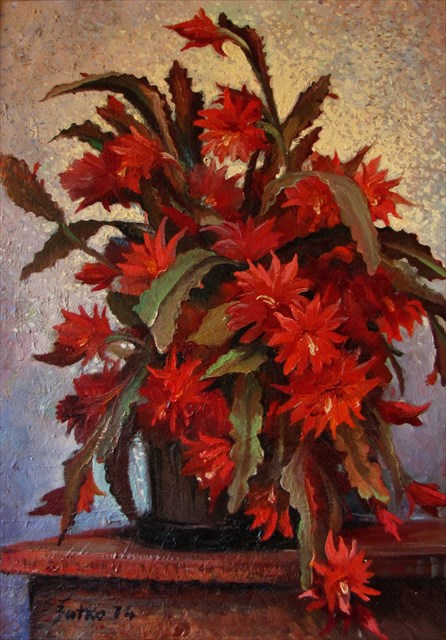
Okrem svojich diel a detí zanechal v priateľoch a známych zážitok jeho nefalšovanej človečiny a čestného, širokého srdca, ktoré malo rovnako blízko ku intelektuálom, ako ku pastierom, zametačom ulíc, predavačom, cudzincom.. Aj preto mu venujem túto kešku. Nielen preto, že pekne maľoval (a že bol mojím otcom); tento kraj môže byť na neho právom hrdý.
..............................................................
Ku skrýši:

Stage 1:
N 48 40.083 E 18 15.267
Úvodné súradnice vás dovedú ku starému mlynu. Dnes to nie je veľmi malebné miesto, ale pred polstoročím ešte fungoval, poháňala ho voda z Bebravy, ktorá po otočení mlynského kolesa pokračovala do kúpaliska, ktoré bolo v lete obľúbeným miestom kúpania Rybancov (viď výrez z obrazu). Márne by ste už hľadali stopy po kúpalisku, dnes je zarastené náletovými drevinami, ktoré tvoria hustú džunglu, plnú smetí. Tam naozaj nemusíte ísť. Je možné sa po úzkom chodníčku idúcom popred mlyn dostať ku dnešnému toku Bebravy (asi 2 min pešo). Hlavne nezabudnite spočítať šteblíky požiarneho rebríka, ktorý je pripevnený k priečeliu opusteného mlyna.
Ak ich je 20, tak A = 7 , ak ich je 22, tak A = 4 , ak ste napočítali 24, A = 8.

Stage 2:
N 48 39.997 E 18 15.477
Názov budovy, ktorú uvidíš pred sebou na námestí je:
„Hostinec“ ( B = 0 ), alebo „Krčma“ ( B = 2 ), alebo „Pub“ ( B = 5 ). Tesne vedľa bol pôvodne dom, kde Jozef trávieval prázdniny s kamarátmi.
Otázka č.3
Nie, už nemusíš nikam ísť, stačilo čítať listing... :-)
Majster Jozef Žatko sa jednej z nasledujúcich vecí nikdy hlbšie nevenoval. Ktorej?
1. včelárstvo (C = 5 )
2. hra na fujare (C = 6 )
3. maľba fresiek (C = 2 )
4. rybolov (C = 3 )
5. hra na klavíri (C = 7 )
6. horolezectvo (C = 1 )
Finál:
N 48 39.AB3 E 18 15.0C5
Veľa šťastia.
..............................................................
ENGLISH version:
Non-googled-informations :-)
Once upon a time the boy was born. He was born on September 13, 1930. They named him with very frequently used name in these village: JOZEF ZATKO (family name with diacritic to „Z“).
As he grow, he helped at home like almost all children from Rybany did; he helped his father to plow, sow, collect the harvest, mow, work around domestic animalson the farm, etc. His mother taught him to be deep emphatic to other people and to the world. During the evenings in their kitchen he had listening to his father experiences of river ship cruises upon Danube river, where he worked as a locksmith. Mother was excellent cook. She served as a housekeeper and cook even in Budapest. Jozef had also two jounger sisters. But mostly he liked to draw with ordinary pencil on empty edges of old newspapers. Here somewhere his painter-career began. As a teenager was happy to organize (together with his two cousins Teodor and Jan) willage performances of the „magician and hypnotist“, in which Jozef turned to illuminator, a manufacturer of lighting effects, theater-curtain mover and assistent for everithing in one person.
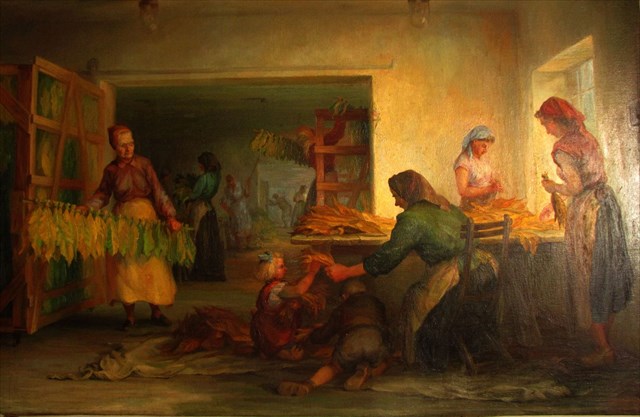
All these factors probably formed Jozef´s professional career and life journey. He became painter, really popular storyteller, family entertainer, skilled home repairer and constructor of all needed, and besides his beautiful marriage with his wife Blanka ( graduated sculptor; single name Blanka Longauerova) became gradually the father of six children. People who remember him know, that they could to talk with him about many different topics: breeding of fruit trees, fertilization of cucumber plants, cutting vine trees, as well as politics, philosophy, classical music, theater, science discoveries, deep belief in Love, masonry, carpentry, reeding travel books; he was keen on taking pictures with his beloved Flexaret, he liked motorbike travels, hiking on mountains, moutain climbing, skiing, playing on fujara, but also loved quiet lonely moments with his fishing rod, hiden somewhere on coves of unregulated Bebrava river.
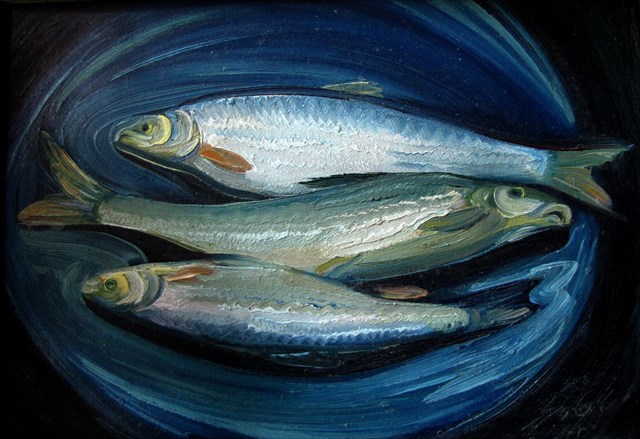
At the Academy of Fine Arts (VSMU Bratislava) studied in classroom od painter and professor Jan Zelibsky, partly painter prof. Vincent Hloznik too. After finishing this Academy was Jozef Zatko worked there as an assistant. In addition to painting, he focused largely a restoration. Some destroyed church frescoes evend newly painted over (see for example Parish Church of St. Peter and Paul in Nitra, called Franciscans). He was also teacher of painting (Topolcany). From paint techniques was using the oil, watercolor, pastel, but his most significant manuscript is reflected in his watercolor works, where he paited with opossite side of brush (wood end), or with palette – knife, to wet painting. His work (Poprad tarn, 1962) you can find in Tatra gallery in Poprad. Anyway, most of his works is still decorating walls of flats, houses and offices. He was known by „giving works rather than selling“. He was built modest atelier-house in the end of parental garden in his native willage Rybany. From family reasons he definitly moved out of Bratislava to Rybany, where he painted, restored paintings and sculpts, devoted to their children, gardenering, beekeeping.. After some years they moved to block-flat in near Banovce nad Bebravou. Small flat was not enough for 8-member family, so they finally bought the old house in center town, which Jozef cultivated during rest of life. He died suddenly on January 27, 1987, as a 56-year-old; at home, in the middle of work, shortly after legendary snow fall calamity. Although he wasn´t experienced any grandchild until he was alive, today he has 14 grandchildren. His paintings isn´t possible to count nowadays.
In addition to his works, children and grandchildren he remained here (in his friend´s and mate´s memories) experience of his genuine humanity and honest, broad heart, which loved people and life.
That´s why I dedicated him this cache. Not only because his works are nicely painted (or because he was my father), but this region can be rightly proud on him.
..............................................................
How to find the cache:
Stage 1:
Go to coordinates of this stage, find old mill building. Try to imagine, that 50 years ago it worked. There was different flow of Bebrava river, water from Bebravamoved mill wheel and next flowed to nice swimming pool, where willagers spended their summers (see picture - golden ages of the mill). Today this isn´t lovely place unfortunately; there´s a jungle of wild trees,full of garbage, instead of swimming pool... (you really do not need to enter into it!) If you want, just walk down the narrow walkway between the mill and that „jungle“ to see Bebrava (2 min by feet).
You need to count, how many steps has the fire ladder on the mill.
If 20, than A = 7, if 22, than A= 4 , if 24, than A = 8.
Stage 2:
Near the white monument on the square look arround, you´ll see some quite big word on near building. You can see:
1. HOSTINEC (B = 0 ), or KRČMA (B = 2 ), or PUB (B = 5 ) ? Jozef spend his childhood in the neighborhood of this house.
Stage 3:
...just a control question from listing :)
Jozef Zatko did NOT do:
1. beekeeping ( C = 5 )
2. playing the fujara ( C = 6 )
3. painting frescoes ( C = 2 )
4. fishing ( C = 3 )
5. playing the piano ( C = 7 )
6. mountain climbing ( C = 1 )
Final: N 48 39.AB3 E 18 15.0C5
Good luck.